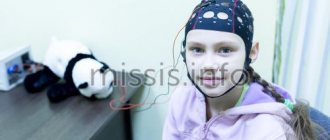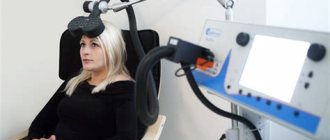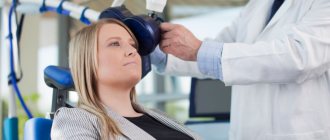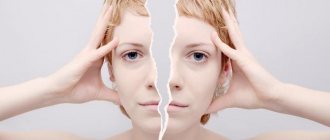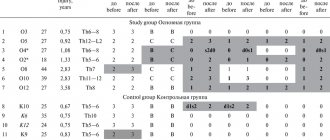In the 70s of the last century, medical scientists at the Institute of Experimental Medicine of the USSR Academy of Medical Sciences discovered micropolarization - a new method of influencing the nervous tissue of the brain (TCMP) and spinal cord (SCMP). The new concept, as well as the development of the basic principles of the method, was born as a result of laboratory experiments by the famous Soviet neurophysiologist N.P. Bekhtereva. and the many years of work of her predecessors: Pfluger E., Verigo B.F., Rusinov V.S., Vvedensky N.N. and other outstanding doctors of his time.
In the course of research, Leningrad scientists studied the reaction of the nervous system to direct currents. It turned out that the targeted effect of low-power on nerve cells helps to achieve positive results in the treatment of diseases of the nervous system.
What is transcranial micropolarization for a child?
Transcranial micropolarization of the brain
is a method of treatment by influencing individual brain structures with a weak direct electric current, comparable to one’s own electrical processes. As a result of exposure, membrane polarization occurs. The procedure helps reduce inflammation and swelling, improve tissue nutrition, the current affects the neurons of the brain, helping to restore neural connections and networks. Experts note that after a course of procedures, patients recover impaired central nervous system functions more quickly, resulting in improved cognitive activity and learning ability.
The impact is on:
- Cortical areas of the brain.
- Segmental points - chest, neck, lower back.
Dysfunction of certain areas of the brain occurs as a result of injuries, unsuccessful operations, and congenital abnormalities. The nervous tissue around the lesion is damaged. As a result, complications such as auditory, motor, visual and speech disorders arise.
Children's micropolarization restores weakened tissue
. The procedure has the greatest effect when combined with physical therapy.
Micropolarization – benefit or harm?
It is considered proven that micropolarization of the brain during speech delay has a positive effect, stimulating and strengthening synaptic connections. In the case of autism, the causes of which are themselves poorly understood, micropolarization is recommended as a method to “try.”
Note! There is no official evidence of the effectiveness of micropolarization for the treatment of autism. The promotion of the method is based on the hypothetical benefits and positive experience in the rehabilitation of adult patients with speech and motor disorders.
It is officially believed that exposure to a weak current for short sessions cannot cause any harm. However, there are conditions in which such treatment cannot be carried out.
Contraindications
Micropolarization is contraindicated in case of individual sensitivity to the action of electrical impulses.
Electrical treatment is not carried out:
- for dermatological diseases localized at the site where the electrodes are attached;
- with increased excitability of patients;
- children with autism who are prone to hysterical reactions;
- patients who have vascular pathologies;
- patients with neoplasms;
- simultaneously with taking psychotropic medications;
- simultaneously with a course of other physiotherapy procedures.
If you have doubts about the benefits of the treatment, you should refuse the procedures. Autism as a disease is poorly understood. Micropolarization in autism remains just as little studied.
Indications:
Doctors refer babies for transcranial micropolarization in Moscow when they diagnose:
- Cerebral palsy.
- Auditory and visual pathologies.
- CNS lesions.
- Delayed psycho-emotional development.
- Impaired concentration and memory.
- Learning difficulties.
- Hyperactivity.
- Hyperkinesis.
- Autism and Down syndrome.
- TBI.
- Aggressiveness, unmotivated fears.
- Bed-wetting.
- Cramps.
- Psycho-speech deviations.
- Stuttering and tics.
How is the treatment carried out?
Before manipulation, electroencephalography is indicated to detect foci of damage. Exposure to currents of physiological intensity usually includes 10 sessions lasting about 30-40 minutes. A helmet equipped with electrodes is placed on the patient's head. If the body is exposed, use a similar belt.
During the session, you can read, play games, and do exercises with a speech therapist. Micropolarization
does not cause pain or discomfort in children.
Integral characteristics of the research results
The total score on the ADHD-DSM-IV scale and the J. Swanson questionnaire were calculated.
More significant changes on the scales were compared:
- INATT (inattention),
- IMP/HYP(hyperactivity/impulsivity),
- ADDH (inattention without hyperactivity).
The score on the ODD scale (oppositional disorder) was changed slightly in these groups and is not presented in the work.
The results are presented in Table 1.
Table 1
Integral characteristics of the results of the J. Swanson questionnaire and the total score on the ADHD-DSM-IV scale (before the rehabilitation course)
| Indicators assessed | Main group n=61 | Comparison group n=37 |
| Total score | 40,64±0,92 | 40,82±0,93 |
| inattention | 14,41±0,96 | 15,11±1,10 |
| hyperactivity/impulsivity | 6,88±1,098 | 8,176±0,85 |
| inattention without hyperactivity | 12,41±0,91 | 12,64±0,89 |
As can be seen from the table, no significant differences were found before rehabilitation in terms of the total scores of the integral characteristic.
During rehabilitation, there was a change in the total score on the ADHD-DSM-IV scale; we took into account its decrease in the main group and the comparison group by at least 25%. Comparative indicators turned out to be ambiguous in the study groups, as illustrated in Figure 3.
Rice. 3. Changes in the total score on the ADHD-DSM-IV scale in the main group and the comparison group.
From Figure 3 it can be seen that the decrease in the overall score as a result of the rehabilitation treatment was statistically significantly expressed in the main group (from 40.64 to 18.53, p = 0.003). In the comparison group, the changes are insignificant and statistically insignificant (decrease from 40.82 to 31 points p> 0.05). Research was conducted on the dynamics of the overall score on the ADHD scale - DSM-IV during 3 rehabilitation courses (the observation period was 12 months), which is clearly seen from Figure 4.
Fig. 4. Dynamics of changes in the total score on the ADHD scale - DSM-IV in the main group and the comparison group (after rehabilitation).
From Figure 4 it can be seen that at the beginning of rehabilitation courses, the total score indicators are similar in the main group and in the comparison group. During the ongoing rehabilitation treatment, the overall score over 12 months decreased statistically significantly in the main group (p < 0.005). A decrease in the main symptoms was noted after 6 months in the main group, the positive effect of micropolarization persisted after 9 and 12 months.
Thus, during the study, there were changes in the total score on the ADHD scale - DSM-IV and the indicators of the modified J. Swanson questionnaire, which is reflected in Table 2:
Table 2.
Integral characteristics of the results of the J. Swanson questionnaire and the total score on the ADHD-DSM-IV scale (before and after the rehabilitation course).
| Indicators assessed | Main group n=61 | Comparison group n =37 | ||
| Before treatment | After treatment | Before treatment | After treatment | |
| Total score | 40,64±0,92 | 18,53±1,1* | 40,82±0,93 | 31,0±0,93 |
| Attention disorders | 14,41±0,96 | 6,53±0,92* | 15,11±1,10 | 14,57±1,23 |
| Hyperactivity / impulsivity | 6,88±1,098 | 2,88±0,58* | 8,17±0,85 | 5,52±0,82** |
| Inattention without hyperactivity | 12,41±0,91 | 5,7±0,76* | 12,64±0,89 | 10,0±0,99 |
Note: * p <0.005, ** p <0.05 (significance of differences compared with the values of indicators before treatment).
As can be seen from the table, a statistically significant decrease in the overall score was noted only in the main group (from 40.64 to 18.53, p=0.003) and not statistically significant in the comparison group (from 40.82 to 31 points p> 0.05 ).There was a statistically significant decrease in scores in the modified J. Swanson questionnaire for INATT manifestations - inattention (from 14.41 to 6.53, p = 0.004), IMP/HYP - impulsivity/hyperactivity (from 6.88 to 2.88, p = 0.004), ADDH - inattention without hyperactivity (from 12.41 to 5.70, p = 0.002) in the main group, IMP/HYP - impulsivity/hyperactivity (from 8.17 to 5.52, p < 0.05 ) in the comparison group and was not statistically significant in the comparison group - for manifestations INATT - inattention (from 15.11 to 14.57, p>0.05), ADDH - inattention without hyperactivity (from 12.64 to 10.0, p>0.05), which is clearly reflected in Figures 5, 6, 7.
Rice. 5 Changes in the indicator of attention impairment during the rehabilitation process. (*p < 0.005)
Rice. 6 Changes in the impulsivity/hyperactivity indicator during the rehabilitation process. (*p < 0.005,** p < 0.05)
In the main group there was an improvement in the overall score and the J. Swanson questionnaire. was observed in 50 (81.97%) children (p = 0.004). These children received 3 full courses of rehabilitation treatment. In 11 children (18.03%), the general condition did not change, which was due to incomplete implementation of the rehabilitation course (one or two full or incomplete rehabilitation courses were carried out) due to independent interruption of treatment and lack of interest on the part of the family.
Rice. 7 Changes in the indicator of inattention without hyperactivity during the rehabilitation process. (*p < 0.005)
In the comparison group, improvement was achieved only in 12 children (32.43%), a state without change was observed in 25 children (67.57%). This is illustrated in Figure 8:
Rice. 8 The effectiveness of treatment according to the J. Swanson questionnaire and the total score of the ADHD-DSM-IV scale for children in the main group and the comparison group.
As a result of the analysis of a survey of parents of patients in the study groups, changes in the following indicators of psycho-emotional state were identified:
- improved sleep;
- the emergence of interest in the surrounding world and activities;
- activation of memory and attention;
- accelerating the formation of correct skills in various speech disorders; the emergence of new sounds and words;
- improvement of appetite.
These changes are reflected in Figures 9 and 10.
Fig.9. Indicators of psycho-emotional status in the main group and comparison group before the rehabilitation course.
As can be seen from Figure 8, these indicators are identical in both study groups before courses of rehabilitation treatment.
The survey of parents of the main group and the comparison group was carried out over a period of 12 months. The results of the survey are shown in Figure 10:
Rice. 10. Indicators of psycho-emotional status over time in the main group and comparison group.
As can be seen from Figures 9 and 10:
- improvement in sleep was statistically significantly noted in the main group (changed from 1.58 to 0.53 p<0.001) and was not statistically significant in the comparison group (from 1.35 to 0.94, p>0.05);
- activation of memory and attention was statistically significant in the main group (from 2.23 to 1.06, p < 0.005) and was not statistically significant in the comparison group (from 2.17 to 1.71, p > 0.05);
- acceleration of the formation of correct skills in various speech disorders was statistically significantly expressed in the main group (from 2.05 to 1.01, p <0.005) and was not statistically significant in the comparison group (from 2.17 to 1.41, p> 0 .05);
- the emergence of interest in the surrounding world and activities was statistically significant in the main group (from 1.94 to 0.88, p < 0.005) and was not statistically significant in the comparison group (from 1.88 to 1.35, p > 0, 05);
- the improvement in appetite was statistically significant in the main group (from 1.29 to 0.77, p <0.05) and was not statistically significant in the comparison group (from 1.23 to 1.06, p > 0.05).
In a comparative analysis of the results of visual assessment of the electroencephalogram after a course of TCMP, positive dynamics were observed in 39 children (63.9%) of the main group and 11 children (29.7%) of the comparison group.
The following positive changes were recorded: an increase in the number of alpha wave groups in the parietal leads of the hemispheres and a decrease in the number of polyphasic potentials in the occipital leads. Quantitative EEG data indicate an increase in the power of alpha waves in the parietal and occipital leads.
Thus, positive clinical changes in children with ADHD, such as inappropriate, inappropriate activity, excessive activity, attention deficit, impulsiveness in social behavior and intellectual activity, problems in relationships with others, low self-esteem, concomitant behavioral disorders, motor awkwardness due to static-locomotor insufficiencies were fully confirmed during a functional study.
TCM results
After completing a course of transcranial micropolarization for children in Moscow, the following positive changes can be noticed:
- Improving social adaptation.
- Increased learning ability.
- Restoration of damaged nerve tissue.
- Normalization of speech and motor functions.
- Increased visual and hearing acuity.
- Normalization of metabolic processes in the brain.
- Alignment of the psycho-emotional background.
- Development of communication skills.
- Elimination of stuttering, burr.
- Activation of mental and creative abilities.
Among the advantages of the TCMP procedure:
- Simple, non-invasive procedure.
- Does not require a recovery period.
- Has a high degree of selectivity of influence.
- Provides a wide range of positive actions.
- Reducing the risks of complications after strokes, surgical interventions and TBI.
The cost of transcranial micropolarization
of the brain is 1,600 rubles (including a -20% discount)
Micropolarization of the brain for children and adults: indications and contraindications
At the moment, the micropolarization method is not widely available due to the difficulty of averaging results due to the use of instruments from different manufacturers and the insufficient number of control studies. However, this method has proven itself well in the treatment of speech therapy and behavioral defects.
What diseases can be treated with TCM of the brain?
Due to the fact that the method has been shown to be quite effective, it can be used both independently and as part of complex treatment in adults and children.
Research shows that TCMP may be a valuable tool in the treatment of:
- Neuropsychiatric diseases such as depression, anxiety, fears, Parkinson's disease, chronic pain, tics
- Cerebral palsy of varying severity
- Organic lesions of the central nervous system
- Vascular diseases of the brain
- Traumatic brain injuries
- After neuroinfectious diseases of the brain
- Neuroses
- Hearing impairment (sensorineural hearing loss)
- Visual impairment (nystagmus, strabismus)
- Speech development disorders in children
- Developmental delay
- Hyperactivity disorder, attention deficit disorder
- Epileptic syndrome
It has been shown that as a result of the use of brain micropolarization, recovery processes after a stroke are enhanced by 3 times, visual acuity is increased by 2 times, and speech functions are improved by 2-3 times. Moreover, in children the effectiveness of the TCMP technique is several times greater than in adults. Studies have shown that after the use of micropolarization of the brain in children with mental retardation, significant changes in socialization and correction of the condition are noted.
In children with attention deficit hyperactivity disorder, TCMP of the brain helps improve cognitive functions of the brain, memory, emotional status of the child, attention, normalizes sleep, and reduces impulsivity.
In case of speech disorders, significant positive changes are observed when influencing the speech areas, and the effect exceeds the result of drug therapy.
Micropolarization can also be used in healthy people to improve brain function during stress (exams, stress, intense intellectual work).
Due to the fact that, unlike other techniques (electroconvulsive therapy, magnetic stimulation, transcranial electrical stimulation), which are contraindicated for epilepsy, a weak micropolarization current can be used to activate the brain’s own anti-epileptic system.
It is important to note that with Down syndrome, early childhood autism and other genetic diseases that affect mental and speech development, micropolization is used with caution due to insufficient knowledge of the diseases. Typically, results are either negligible or non-existent. No deterioration of the condition was observed.
There are a number of contraindications to the use of brain micropolarization:
- Individual intolerance to electric current;
- Tumors;
- Colds and infectious diseases;
- Increased body temperature;
- Presence of foreign bodies in the skull (tissue substitute);
- Systemic blood diseases;
- Hypertonic disease;
- Severe cerebral atherosclerosis;
- Damage to the skin in the affected area.
The procedures are incompatible with nootropic therapy, acupuncture, MRI, vibration stimulation and electrical muscle stimulation, and the use of various strong psychotropic drugs.
This method can only be used by a qualified neurophysiologist in a medical institution after prior consultation with a therapist.
